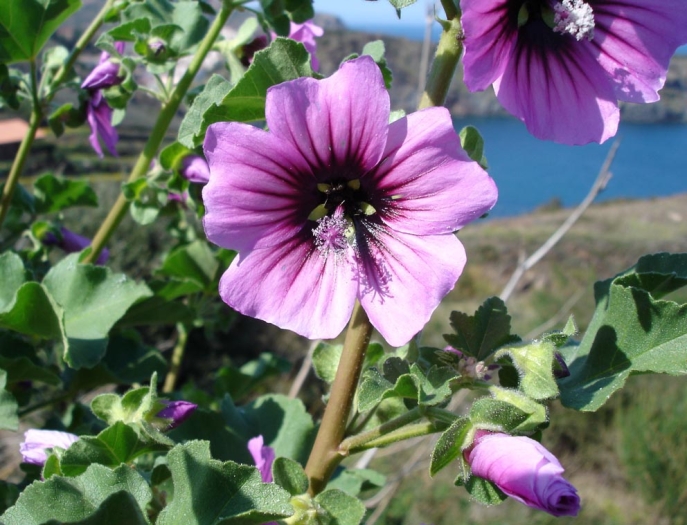Tree Mallow
(Malva arborea)
Tree Mallow (Malva arborea)
/
/

Jean Tosti
CC BY-SA 3.0
Image By:
Jean Tosti
Recorded By:
Copyright:
CC BY-SA 3.0
Copyright Notice:
Photo by: Jean Tosti | License Type: CC BY-SA 3.0 | License URL: http://creativecommons.org/licenses/by-sa/3.0/ | Uploader: Jeantosti | Publisher: Wikimedia Commons | Title: Lavatera_arborea2.jpg | Notes: User created page with UploadWizard |





















































Estimated Native Range
Summary
Malva arborea, commonly known as Tree Mallow, is an evergreen shrub native to coastal areas and islands of the Mediterranean region and the Atlantic coast, where it often grows in saline environments such as coastal cliffs and salt marshes. It typically reaches a height of 0.5–2 meters, and on rare occasions, it can grow up to 3 meters tall. The plant has a bushy form with orbicular leaves that are 8–18 cm in diameter, palmately lobed with five to nine lobes, and a coarsely serrated margin. Tree Mallow is notable for its showy flowers, which are 3–4 cm in diameter, dark pink to purple, and grow in fasciculate axillary clusters of two to seven. The flowering season extends from early summer to autumn, providing a long-lasting display of color.
Tree Mallow is appreciated for its tolerance of salt spray and its ability to thrive in coastal gardens, making it a suitable choice for seaside plantings. It is also used for ornamental purposes in borders and as a specimen plant. In cultivation, it requires well-drained soils, moderate watering, and can tolerate a range of light conditions from full sun to partial shade. While it is generally easy to maintain, it can be susceptible to rust and other fungal diseases. Gardeners should be aware that Malva arborea can become invasive outside its native range, so it is important to check local regulations before planting.CC BY-SA 4.0
Tree Mallow is appreciated for its tolerance of salt spray and its ability to thrive in coastal gardens, making it a suitable choice for seaside plantings. It is also used for ornamental purposes in borders and as a specimen plant. In cultivation, it requires well-drained soils, moderate watering, and can tolerate a range of light conditions from full sun to partial shade. While it is generally easy to maintain, it can be susceptible to rust and other fungal diseases. Gardeners should be aware that Malva arborea can become invasive outside its native range, so it is important to check local regulations before planting.CC BY-SA 4.0
Plant Description
- Plant Type: Shrub
- Height: 5-6 feet
- Width: 3-4 feet
- Growth Rate: Rapid
- Flower Color: Pink, Purple
- Flowering Season: Winter, Spring, Summer
- Leaf Retention: Evergreen
Growth Requirements
- Sun: Full Sun
- Water: Medium
- Drainage: Medium
Common Uses
Bank Stabilization, Bee Garden, Bird Garden, Butterfly Garden, Deer Resistant, Drought Tolerant, Hummingbird Garden, Rabbit Resistant, Salt Tolerant, Showy Flowers
Natural Habitat
native to coastal areas and islands of the Mediterranean region and the Atlantic coast, where it often grows in saline environments such as coastal cliffs and salt marshes
Other Names
Common Names: Baum-Malve, Jättemalva, Baum-Lavatere, Echte Strauchpappel, Malva Arborea
Scientific Names: , Malva arborea, Lavatera arborea, Malva dendromorpha, Malva eriocalyx, Althaea arborea, Malva umbellata, Anthema arborea, Lavatera eriocalyx, Malva fastuosa,
GBIF Accepted Name: Malva arborea (L.) Webb & Berthel.